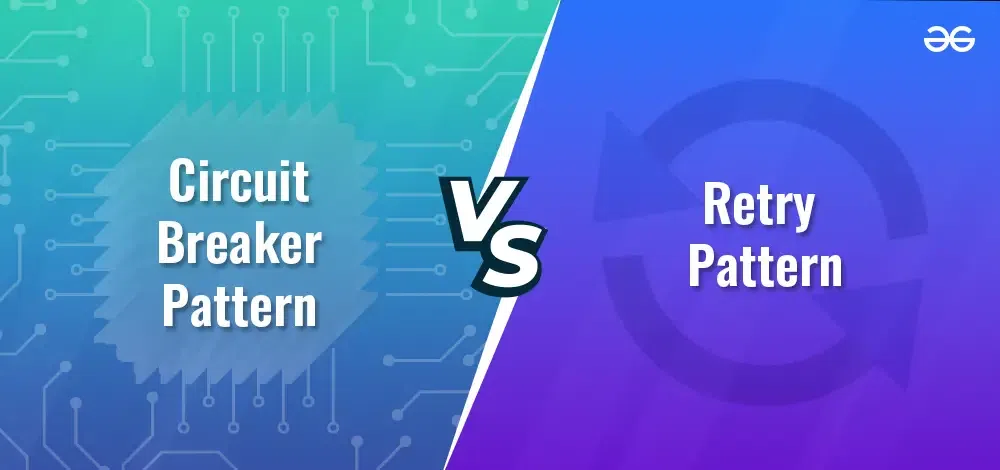Circuit Breaker vs. Retry Pattern
Last Updated :
04 Apr, 2024
In software development, ensuring that applications remain resilient in the face of failures is crucial. Two key strategies that developers employ to enhance resilience are the Circuit Breaker and Retry patterns. These patterns offer solutions to handle failures gracefully and maintain system stability.

Differences Between Circuit Breaker and Retry Pattern
What is a Circuit Breaker Pattern?
The Circuit Breaker pattern in microservices is a fault-tolerance mechanism that monitors and controls interactions between services. It dynamically manages service availability by temporarily interrupting requests to failing services, preventing system overload, and ensuring graceful degradation in distributed environments.
- The Circuit Breaker pattern enables a fail-fast mechanism, where faulty or degraded services are identified and isolated promptly.
- By transitioning to an open state and blocking requests to the failing service, the Circuit Breaker prevents prolonged waits and timeouts, leading to faster error recovery and improved user experience.
- Implementing the Circuit Breaker pattern requires maintaining state information about the health and status of services.
- Managing this state, especially in distributed environments, can be challenging and may introduce complexity, particularly when dealing with concurrent requests and state synchronization.
What is the Retry Pattern?
The Retry Pattern is used in software development to handle transient faults or errors by automatically retrying failed operations. It provides a mechanism to retry an operation that has failed temporarily, with the hope that subsequent attempts will succeed. The Retry Pattern is commonly used in distributed systems, network communications, and interactions with external services where failures may occur due to temporary issues such as network congestion, timeouts, or resource unavailability.
- Retrying failed operations transparently without requiring user intervention helps maintain a seamless user experience.
- Users are less likely to encounter errors or disruptions, leading to increased satisfaction and engagement with the application.
- In scenarios where multiple components or services in a distributed system experience simultaneous failures, retries initiated by downstream services can lead to cascading retry storms.
- Managing retry storms and preventing amplification of failures require coordination and synchronization between components to avoid worsen the situation.
Circuit Breaker vs. Retry Pattern
Below are the differences between Circuit Breaker and Retry Pattern:
| Aspect |
Circuit Breaker Pattern |
Retry Pattern |
| Purpose |
Prevents repeated calls to a failing service by temporarily blocking requests when a failure threshold is exceeded |
Retries failed operations automatically with the hope of success on subsequent attempts |
| Response to Failures |
Blocks requests to a failing service to prevent cascading failures and reduce load on the system |
Retries failed operations without blocking, with the goal of eventually succeeding |
| State Management |
Maintains states (e.g., closed, open, half-open) based on the health of the service and previous failures |
Does not maintain state; each failure is retried independently |
| Fault Detection |
Monitors the health of services to detect failures, transitioning between states based on predefined thresholds |
Detects individual failures and retries them immediately or after a short delay |
| Granularity of Control |
Provides fine-grained control over service access, allowing for dynamic adaptation based on service health |
Offers less control over retries, typically retrying all failed operations with the same settings |
| Handling Transient Faults |
Effectively handles transient faults by blocking requests and allowing the service to recover |
Attempts to mitigate transient faults by retrying failed operations, but may not prevent cascading failures |
| Latency Impact |
May introduce latency during state transitions or when requests are blocked in the open state |
Can introduce latency due to repeated retries, especially if retries are performed sequentially with fixed intervals |
Conclusion
In conclusion, both the Circuit Breaker and Retry patterns offer valuable strategies for handling failures and enhancing system resilience.
- The Circuit Breaker pattern proactively prevents cascading failures by temporarily blocking requests to failing services, providing fine-grained control and dynamic adaptation.
- On the other hand, the Retry pattern focuses on automatically retrying failed operations in the hope of eventual success, offering simplicity and flexibility.
The choice between these patterns depends on the specific requirements of the application, with the Circuit Breaker pattern suited for fault isolation and the Retry pattern for handling transient faults. Overall, both patterns play crucial roles in maintaining system stability and reliability.
Share your thoughts in the comments
Please Login to comment...